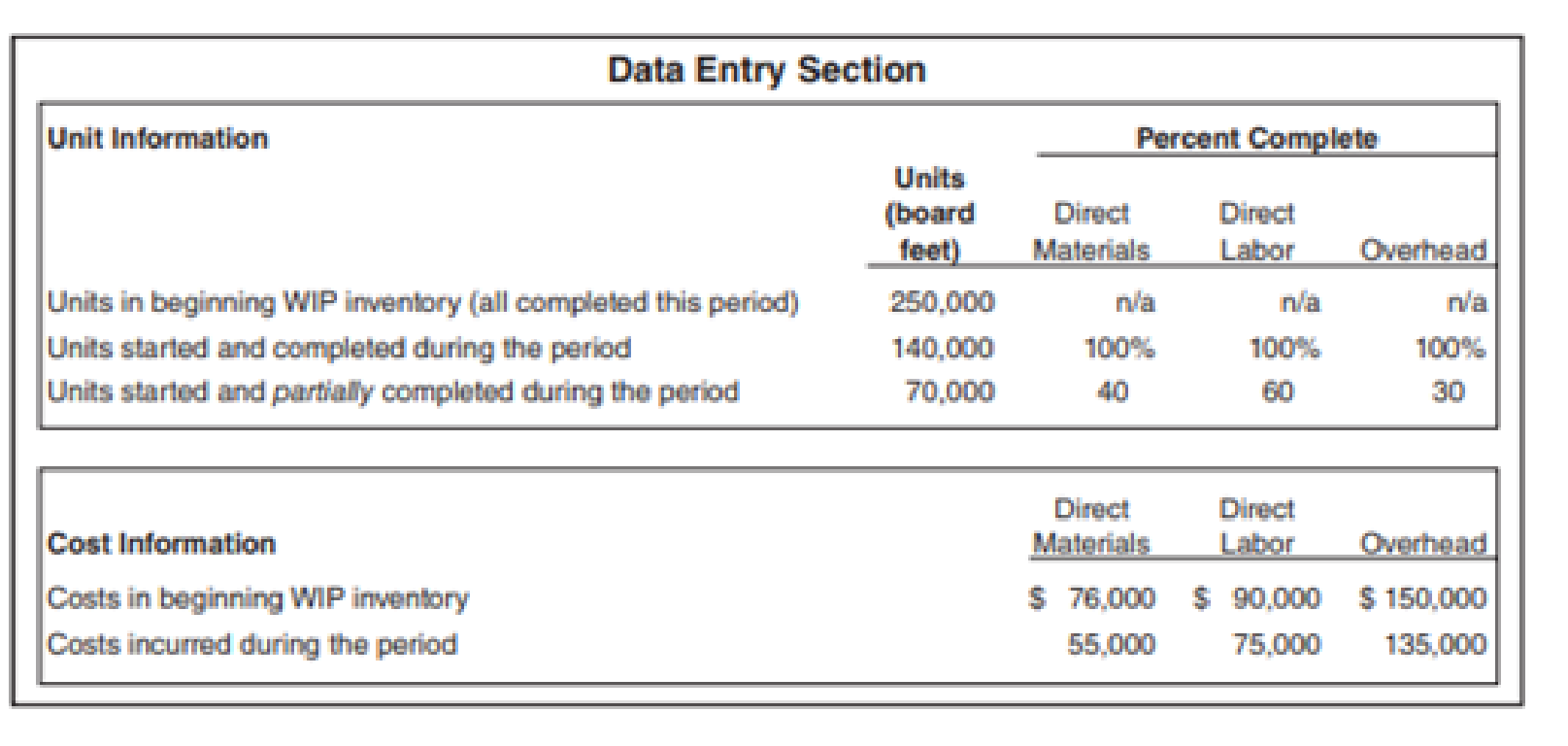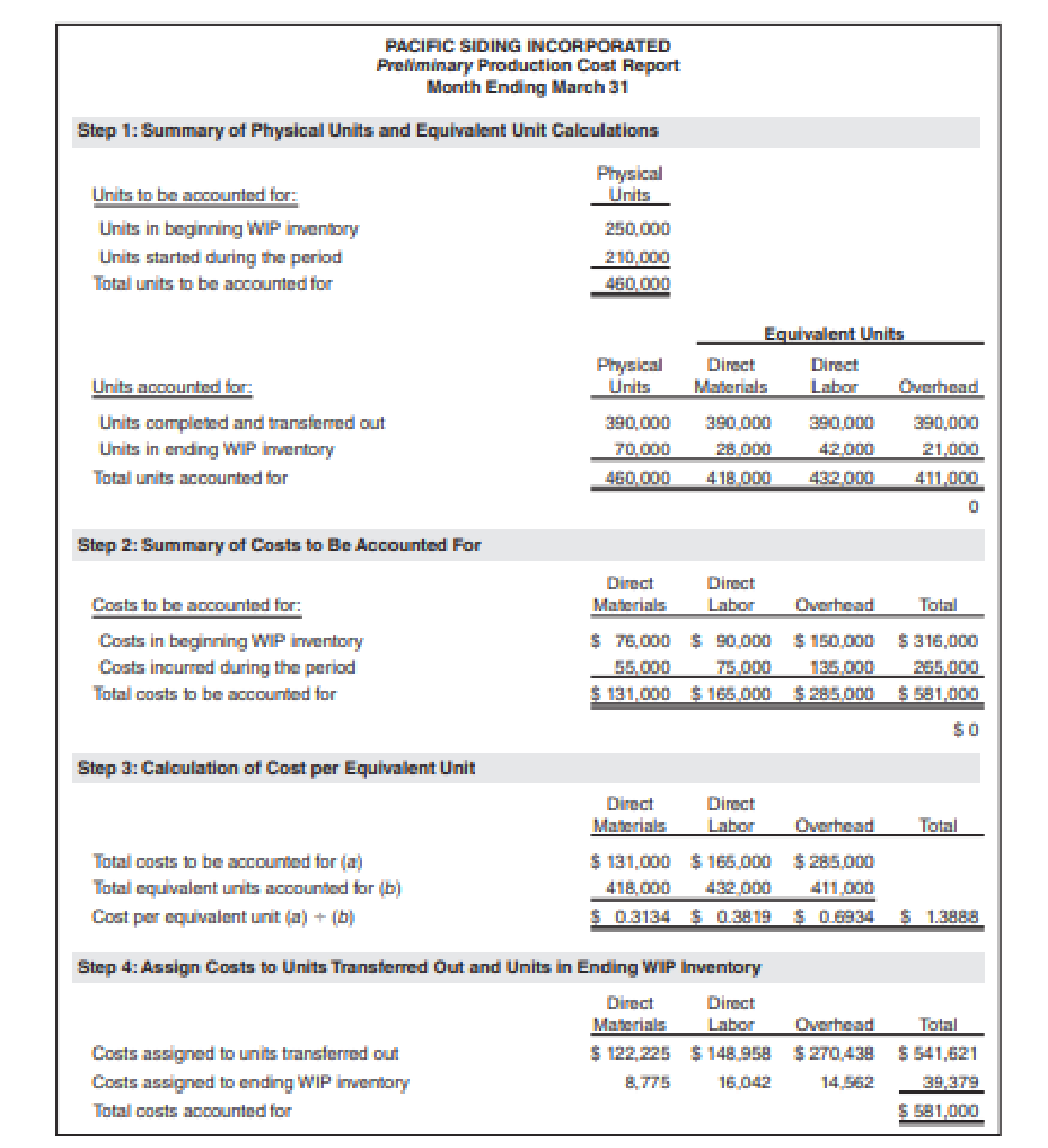
Pacific Siding Incorporated produces synthetic wood siding used in the construction of residential and commercial buildings. Pacific Siding’s fiscal year ends on March 31, and the weighted-average method is used for the company’s process costing system.
Financial results for the first 11 months of the current fiscal year (through February 28) are well below the expectations of management, owners, and creditors. Halfway through the month of March, the chief executive officer (CEO) and the chief financial officer (CFO) ask the controller to estimate the production results for the month of March in the form of a production cost report (the company has only one production department). This report is shown below.
Armed with the preliminary production cost report for March, and knowing that the company’s production is well below capacity, the CEO and CFO decide to produce as many units as possible for the last half of March, even though sales are not expected to increase any time soon. The production manager is told to push his employees to get as far as possible with production, thereby increasing the percentage of completion for ending WIP inventory. However, since the production process takes three weeks to complete, all of the units produced in the last half of March will be in WIP inventory at the end of March.
Required
- a. Explain how the CEO and CFO expect to increase profit (net income) for the year by boosting production at the end of March. Assume that most
overhead costs are fixed. - b. Using the following assumptions, prepare a revised estimate of production results in the form of a production cost report for the month of March. Assumptions based on the CEO and CFO request to boost production:
- (1) Units started and partially completed during the period will increase to 225,000 (from the initial estimate of 70,000). This is the projected ending WIP inventory at March 31.
- (2) Percentage of completion estimates for units in ending WIP inventory will increase to 80 percent for direct materials, 85 percent for direct labor, and 90 percent for overhead.
- (3) Costs incurred during the period will increase to $95,000 for direct materials, $102,000 for direct labor, and $150,000 for overhead (recall that most overhead costs are fixed).
- (4) All units completed and transferred out during March are sold by March 31.
- c. Compare your new production cost report with the one prepared by the controller. How much do you expect profit to increase as a result of increasing production during the last half of March?
- d. Is the request made by the CEO and CFO ethical? Explain your answer.


Want to see the full answer?
Check out a sample textbook solution
Chapter 8 Solutions
FUNDAMENTALS OF...(LL)-W/ACCESS>CUSTOM<
- What is the total cost of job.... Please answer the general accounting questionarrow_forwardArmour, Inc., an advertising agency, applies overhead to jobs on the basis of direct professional labor hours. Overhead was estimated to be $226,000, direct professional labor hours were estimated to be 28,000, and direct professional labor cost was projected to be $425,000. During the year, Armour incurred actual overhead costs of $205,200, actual direct professional labor hours of 23,900, and actual direct labor costs of $333,000. By year-end, the firm's overhead wasarrow_forwardWhat is the degree of opereting leverage? General accountingarrow_forward
- Given correct answer financial accounting questionarrow_forwardPlatz Company makes chairs and planned to sell 4,100 chairs in its master budget for the coming year. The budgeted selling price is $36 per chair, variable costs are $17 per chair, and budgeted fixed costs are $45,000 per month. At the end of the year, it was determined that Platz actually sold 4,400 chairs for $145,700. Total variable costs were $50,375 and fixed costs were $38,000. The volume variance for sales revenue was: a. $14,500 unfavorable b. $11,200 favorable c. $10,800 favorable d. $12,700 favorablearrow_forwardProvide correct answer the general accounting questionarrow_forward
- Helparrow_forwardWhat is the degree of opereting leverage?arrow_forwardSimba Company's standard materials cost per unit of output is $13.63 (2.35 pounds * $5.80). During July, the company purchases and uses 3,000 pounds of materials costing $17,200 in making 1,450 units of the finished product. Compute the total, price, and quantity materials variances.arrow_forward
 Managerial AccountingAccountingISBN:9781337912020Author:Carl Warren, Ph.d. Cma William B. TaylerPublisher:South-Western College Pub
Managerial AccountingAccountingISBN:9781337912020Author:Carl Warren, Ph.d. Cma William B. TaylerPublisher:South-Western College Pub Financial And Managerial AccountingAccountingISBN:9781337902663Author:WARREN, Carl S.Publisher:Cengage Learning,
Financial And Managerial AccountingAccountingISBN:9781337902663Author:WARREN, Carl S.Publisher:Cengage Learning,- Principles of Accounting Volume 2AccountingISBN:9781947172609Author:OpenStaxPublisher:OpenStax College
 Managerial Accounting: The Cornerstone of Busines...AccountingISBN:9781337115773Author:Maryanne M. Mowen, Don R. Hansen, Dan L. HeitgerPublisher:Cengage Learning
Managerial Accounting: The Cornerstone of Busines...AccountingISBN:9781337115773Author:Maryanne M. Mowen, Don R. Hansen, Dan L. HeitgerPublisher:Cengage Learning Cornerstones of Cost Management (Cornerstones Ser...AccountingISBN:9781305970663Author:Don R. Hansen, Maryanne M. MowenPublisher:Cengage Learning
Cornerstones of Cost Management (Cornerstones Ser...AccountingISBN:9781305970663Author:Don R. Hansen, Maryanne M. MowenPublisher:Cengage Learning





